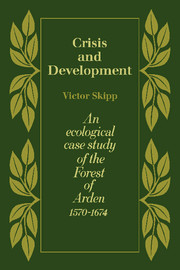Book contents
- Frontmatter
- Contents
- List of figures
- List of tables
- Acknowledgements
- PART ONE THE CONTEXT
- PART TWO THE CASE STUDY
- 4 The demographic crisis of 1613–19
- 5 Negative responses
- 6 The ecological problem
- 7 Positive responses: agrarian change
- 8 Positive responses: new employment openings
- 9 Model of demographic, economic and social developments, 1575–1649
- 10 The new ecological regime, 1625–74
- 11 The social cost
- PART THREE IMPLICATIONS
- Appendix 1 The practice of birth control
- Appendix II Estimates of population size
- Notes
- Index
7 - Positive responses: agrarian change
Published online by Cambridge University Press: 05 November 2011
- Frontmatter
- Contents
- List of figures
- List of tables
- Acknowledgements
- PART ONE THE CONTEXT
- PART TWO THE CASE STUDY
- 4 The demographic crisis of 1613–19
- 5 Negative responses
- 6 The ecological problem
- 7 Positive responses: agrarian change
- 8 Positive responses: new employment openings
- 9 Model of demographic, economic and social developments, 1575–1649
- 10 The new ecological regime, 1625–74
- 11 The social cost
- PART THREE IMPLICATIONS
- Appendix 1 The practice of birth control
- Appendix II Estimates of population size
- Notes
- Index
Summary
A detailed discussion of agrarian change, based on the analysis of 217 probate inventories by forty-year periods (1530–69, 1570–1609 and 1610– 49), has been published elsewhere. The most fundamental development was a shift in the balance between pasture and arable. However, this adjustment in primary land use did not take place until after 1610. In the period 1530–69 only about a third of the land was being used for the growing of arable crops, about two-thirds being pasture. The same traditional land-use pattern persisted during the forty years 1570–1609 – i.e., the period which has now been identified as one of steady population build-up (Table V and Fig. 21). But then, in the period 1610–49 – or in other words, the period which accompanied and followed the 1613–19 crisis – the arable/pasture ratio is adjusted to roughly 50:50. Over the previous eighty years crops had accounted for only 17 or 18% of the total farm value: now there is a rise to 31 %. This mounting interest in arable cultivation is shared by all categories of farmer, from the 60–100 acre yeoman down to the lesser husbandman with 10–15 acres. At the same time, it is the big farmer who is most committed to the new trend, his crop value advancing from 16.8% of the appraised produce (including draught animals) to 37.4%, as compared with the small peasant's movement from 14.2 to 23.3 %. Moreover, this proves to be the establishment of a long-term trend. By the period 1650–89 the arable/pasture ratio has moved to 60:40.
- Type
- Chapter
- Information
- Crisis and DevelopmentAn Ecological Case Study of the Forest of Arden 1570–1674, pp. 42 - 54Publisher: Cambridge University PressPrint publication year: 1978



